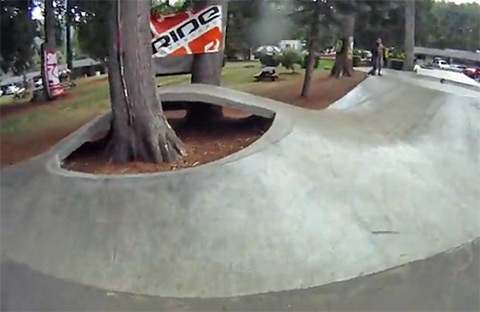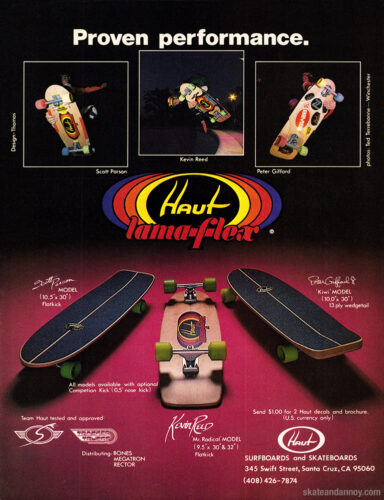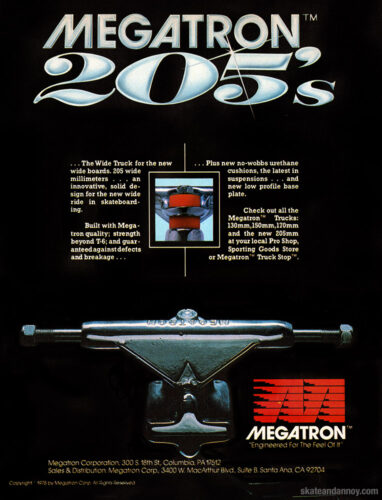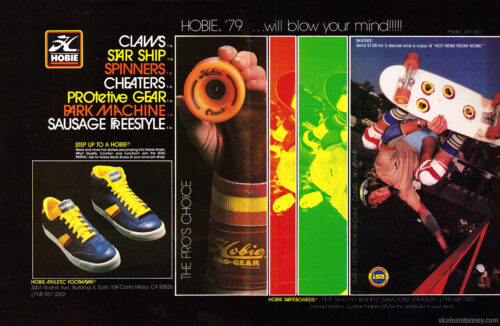
Windells video
Lots of interest in the new concrete at WIndells. You can hear about in a recent interview with Billy Coulon over on Callin on Colin. Hre’s some video footage of the park shot by KC. It looks like a heckuva lot of lines and possibilities. I need to drag my lazy ass out there. Oh yeah, also included, official Windells contest video from earlier this summer.
https://vimeo.com/12663622










Whooooooow,skatepark of dreams AND the mighty Ramones.That’s it,I’m done for today.
I love that song!
That park looks like so much fun. the kind of place I could envision skating until you’re like in your 60’s.
Shades of Tamoka Moonforrest skatepark! Not that I ever skated there… but I would see its concrete lined trees in the upside down, back part of WaveRider magazine (otherwise known as SkateRider magazine), way back when.
Hey Cave Man, I skated a lot of Central Florida parks, and Tomoka Moonforest was one of my favorites. Tampa had lots of space for tricks, but Tomoka was IN THE SHADE! And the snake runs and big bowl were a new challenge for me!
I remember that the big problem with the parks, though, was the cost of insurance for the owners. That’s why most of them bailed. I’m stoked that I was in the generation that had the best parks. West Palm Beach has a city park now, but it’s pretty sad compared to Skateboard Safari, which I rode in the late 70s. Sigh. Great memories, though!
Not that anybody here (thankfully) much cares, but when I googled Tomoka Moonforest skatepark out of curiousity, I wound up finding out something funny about the first ever session at a true bowl in a skatepark, in February of 1976. Aspiring pro surfers Greg Mungal, Jeff Klugel, and Jacky Grayson, with Bruce Walker filming (and no doubt skating it himself), rode the bowl at Skatboard City near Daytona, the day after it was poured, at dawn before the construction crew showed up… the month before Carlsbad was finished to usher in California’s skatepark era. The “funny” thing being that two or three of those guys were actually in Larry Bertleman’s league as surfers, so they were skating for skating’s sake, instead of cuz they couldn’t surf like Bert and so wanted to roll like he surfed (Dogtowners’ excuse). Grayson (like Bertleman) was a very early proponent of modern twin fins, and Klugel, an early aerialist and twin fin ripper, is now one of the WCT judges, and Mungal, a twin fin powerist, took second? to the inventor of the modern tri-fin at the Bells Beach contest in Australia, and won at Huntington and Trestles against top international comp. The point??? being, twin fins are more like skating (free-er “grinds”), and those guys, if they hadn’t been busy forking surfing in the road, and had had a media voice, might have rivaled “Dogtown (We Invented The Frontside Air even though Jim McCall did one months earlier in front of thousands at the West Palm Beach Auditorium) Inc”. Of course, those three didn’t go big in the skating fork… but were there really any transition moves that the Dogtowners innovated? I mean, I saw Bertleman in ’78 crank off the bottom backside in Sebastian shorebreak and then instantly and smoothly switch stance on the roof of the dumping wave before pulling the re-entry. And I don’t think the Dogtowners were responsible for anything comparable (that somebody elsewhere wouldn’t have pulled the same year), except for successful emulation of Bertleman’s media hunger. Jay Adams could crank a mean bottom turn, though… maybe he should have forked surfing harder? Or kept skating as hard as he started partying? (So he could have done the first media invert by being on the cover of WaveRider and SkateRider??)
Amazing what you can find on the internet these days. Not sure who Cave Man is, but his observations are very astute and accurate as far as I can tell, in that they match my first-hand memory of these same events. Documentation of key events in 1970’s skateboarding is scarce since the internet didn’t exist back then, and the skaters involved in “historic moments” were not always aware at the time that history was being made, so they didn’t keep notes and write down dates and other key information at the time it actually happened. Being able to look back and piece together these events with proper time, place, and the participants involved is a bit of a challenge when it’s finally done, years later. Different clues present themselves that allow an accurate story to be told, but there are never as many of these clues available as we would hope for. Some that come to mind would be that we can certainly document the opening dates of Skatboard City in Port Orange, Florida in early March, 1976, as compared to the opening of Carlsbad Skate Park in California approximately 2 weeks later. That never stopped the California-based skateboard media from claiming Carlsbad to be the world’s first skate park. That inaccurate claim went on for years, even after they were properly informed that Port Orange opened before Carlsbad. Another example is Glen E. Friedman’s proclamation on-camera in “Dogtown and Z-Boyz” that the Dogtown crew started landing aerials in September, 1977. He would know, because as a key photographer in skateboarding’s early days, he shot color slides for the most part, and slides always have a date stamped on them. This proclamation by Friedman allowed us to establish that Florida’s Jim McCall beat them to it, as Cave Man pointed out McCall’s successful aerials at the West Palm Beach auditorium. Today, November 5, 2011 Jim McCall phoned me to inform that he found in his storage room, the actual poster for the Van, Surf, and Skateboard Expo at the West Palm Beach auditorium, dated June 18-19, 1977. I had previously thought the Expo was in July, 1977. The poster listed skateboard demos from Mike Weed, Hobie Teamrider and Jim McCall, Walker Teamrider. This puts McCall’s frontside airs almost 3 months ahead of the Dogtown crew’s first successful landings. For now, we can use McCall as the gold standard for the first aerials in skateboarding, at least unless someone else comes up with documentation that shows successful aerials prior to June 18-19, 1977. To date, I’m not aware that any such event or information has been established or put forward by anyone else. I haven’t heard of any other specific, documented claims, regarding aerials. This is the best method we have available to us, in trying to piece together the history of skateboarding and surfing. An interesting note regarding aerials in surfing: recently Nathan Pratt, an original Z-Boy was asked by Craig Snyder about aerials in surfing. He apparently credited the McClure brothers as having pulled off surfing aerials as early as 1984 in California. We’ve already documented that Matt Kechele was pulling off Ollie Airs at Sebastian Inlet, Florida in Spring, 1979 on his Ocean Avenue twin-fin. Ocean Avenue’s Jeff Klugel was there when Kech did his first “Kech Air” and soon joined Kechele as one of the sports first aerialists, as correctly pointed out by Cave Man. By 1980 Florida’s John Holeman began doing aerials in the ocean, and by 1981 Holeman was landing 180 degree aerials and soon thereafter, the 360 Air. It’s my understanding that Kevin Reed of Santa Cruz was an aerial pioneer in surfing and his flyaway kick-out appeared early-on on the cover of Surfing Magazine. There doesn’t seem to be enough info available on the specifics of Reed’s first successful airs though, as it’s generally believed that he didn’t land the cover shot kickout (not to mention that even if he did land it, continuing the ride after the aerial is an important element to a successful aerial). I’ve continued to keep an eye out for any documentation regarding aerials from Kevin Reed. I’m not sure it’s been properly established where he actually fits into the aerial timeline of surfing (or skateboarding, for that matter). Keep an eye out for Craig Snyder’s (2) new books about to be released, regarding his research into the history of aerials in skateboarding, surfing, and even wakesurfing/wakeboarding. With Florida’s Alan Gelfand (Powell/Peralta Team) introducing the ollie air and Florida’s Rodney Mullen (Ocean Avenue/Walker Team) applying the ollie to flat ground and street skating, it appears that generally speaking, all roads lead to Ocean Avenue. A major motion picture is potentially in the works, establishing the East Coast’s evolution, separate from California, and this film could rock the established foundation of California as center-of-the-universe in these sports. Enough said for now . . . Bruce Walker
Oh god, say it ain’t so, Bruce… does our “side” WANT to claim like them? (Actually, though, I’ve got nothing against valid claims about skating… OR for that matter, validly excited “claims” in the surf [which Californians seem to have a bugaboo about].) I would not be surprised if some people’s claims that Kevin Reed was landing 70’s airs in Northern California surf are true, though… cuz the only picture I’ve seen of him grinding coping looked particularly good… although I realize that skate talent doesn’t always translate to surf talent. Interesting though how webcast commentators (I think Pancho Sullivan) at the Rip Curl Pro going on in San Francisco this week were noting that John John Florence gets his “quiet” front arm from skating… which he’s supposed to be good at. That doesn’t look as good to me on a surfboard, however, and I think he could get more drive by lifting his arm down the line occasionally (but hey, he’s more than twenty years younger than Slater; time he’s got).
I skated with skateboard expo in 1977 with Bruce Logan.My name is Tim W. Lonctot
You can contact me at (209) 384-3473 Cell is (209) 756-3473
My name is
Caveman and Bruce,
Awesome input and info! These posts are a little old so I don
For more California real, check out outta-ideas-and-roots Danes the Raveonette’s song “Z-Boys”, and Jaden Smith’s “Pumped Up Kicks (Like Me)”, on Youtube, for further skate-ploitation. Don’t start no dreck won’t be no dreck, Stecyk.
(Ooh, maybe somebody needs to do a Tick-like, larger-than-life superhero named Dreck Stecyk, whose power would of course be publicity.)